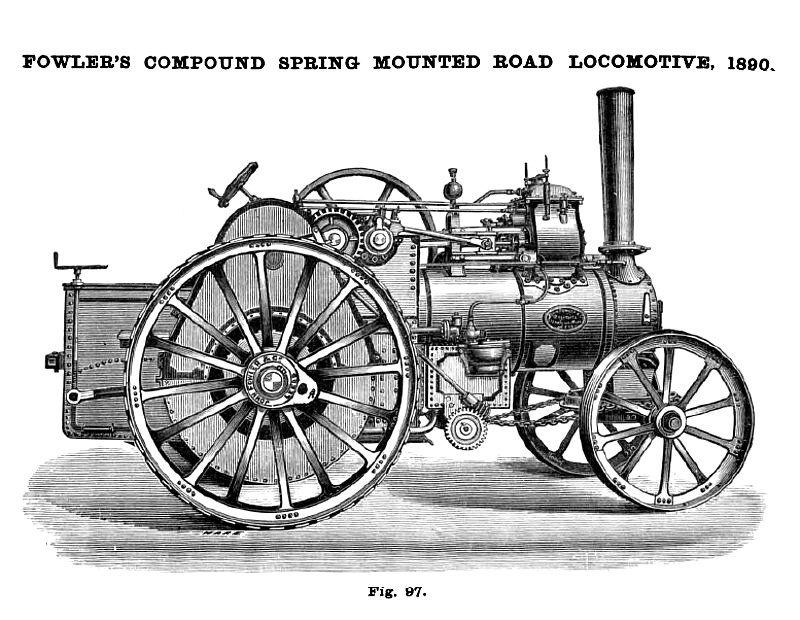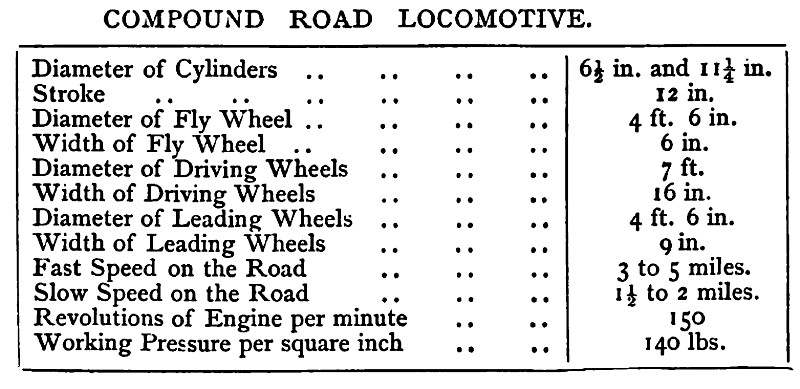|
Title: |
1891 Article-John Fowler & Co., Compound Spring Mounted Steam Road Locomotive |
|
Source: |
History & Development of Steam Locomotion on Common Roads, 1891, pgs. 224-228 |
|
Insert Date: |
12/14/2014 8:46:47 PM |
Another celebrated and well-known firm engaged in the manufacture of road locomotives is Messrs. John Fowler and Co., of Leeds, who have during the last thirty years or more, made the construction and use of traction engines their special study, having in this lengthened period carried out the most extensive and exhaustive experiments quite regardless of expense.
In passing we may mention that Messrs. Fowler occupy a preeminent position as manufacturers of steam ploughing machinery, as their prize list will show. We have only space to name some of the leading improvements this eminent firm has effected in road locomotion. At the Wolverhampton Show of the R.A.S.E., in 1871, Messrs. Fowler exhibited two twelve horse-power road locomotives containing some interesting features, one of these engines was fitted with Aveling and Greig's wheels, with India rubber tyres in segments, as described under Messrs. Aveling's name. One of these engines was mounted on three rigid wheels, the front wheel turned in a ring, supporting the weight of the forward part of the engine either by a number of balls or by rollers, the fore-carriage thus formed being steered by means of a worm, worm-wheel and pitched chain. This engine was provided with a single cylinder, completely steam jacketed and lagged, and combined with a spacious dome, the safest and simplest remedy against priming; steam was taken from the smoke-box end of the boiler, the driest part of the steam space. The fire-box shell side plates were carried up to support the shafts in the well-known manner introduced by Messrs. Aveling and Porter. A tank under the boiler barrel was provided, while all the moving parts were cased in to avoid frightening horses. In 1878, Messrs. Fowler introduced a simple arrangement of inside gearing—Aveling and Greig's patent. But the two chief points Messrs. Fowler have for years incessantly aimed at are, first: the perfecting of the compound cylinder system to road locomotives; and second: mounting the engines on an effective arrangement of springs. These two problems have been successfully solved. The peculiar advantages of both improvements are very well known and appreciated.
We now pass on to notice Messrs. John Fowler's recent type of compound road locomotive mounted upon springs, as illustrated by Fig. 97.
By the use of a low pressure cylinder working in conjunction with a high-pressure cylinder, the greatest possible amount of expansion is obtained, and almost all the power in the steam is used before it is discharged into the atmosphere, the pressure of the exhaust steam being only 8 lbs., which is just sufficient to create a draught necessary for the combustion of the fuel. These engines will do the same amount of work with 30 per cent, less fuel and water than the ordinary engines
in every-day use. For example, where an ordinary engine consumes, say 6 cwt. of coal for a day's work, a compound engine will only require 4 cwt., and with the same quantity of water to start with, the compound engine will travel at least one-third greater distance than the ordinary high pressure engine. In consequence of the steam passing from these engines into the atmosphere at the low pressure of 8 lbs., the noise caused by the exhaust, and all dangers from sparks are avoided, and the engine rendered much less objectionable to horses than the ordinary single-cylinder engine. The crankshaft and second-motion shaft are supported by the firebox shell side plates, which are carried upwards, and strongly stayed by cross plates.
The injurious strain of the engine on the boiler is thus reduced to a minimum, and the weakening effects of bolting the brackets on the boiler avoided. The bearings are accurately fitted into recesses cut in these plates, and are also securely riveted to them. By this arrangement all the strain is taken by the plates themselves, the rivets merely hold the bearings in their places, and prevent any danger resulting from them giving way.
To combine the greatest possible strength with the requisite lightness, the boiler is entirely constructed of steel. The fire-box has a round instead of a flat top; and there is no danger from sediment accumulating on the top of the fire-box. All the longitudinal seams are double riveted, plates planed on the edges, and the flanging done by hydraulic pressure. The boilers are strongly stayed throughout, to work at a pressure of 150 lbs. per square inch, and tested to 250 lbs. per square inch, and are equal in strength and workmanship to the best locomotive boilers. The draw bar is so arranged that the whole of the pull is taken by the boiler side plates, and the tank relieved of all strain.
This engine shown by Fig. 97 is mounted on springs. Messrs. Fowler refer to the spring arrangement as follows "The want of springs on traction engines, especially those used for running on hard and rough roads, has long been felt, and has proved a hindrance to their extended use. It has limited their speed, and increased the wear and tear. After experimenting for many years to find some means of allowing the shafts on which the gearing runs, to vary their relative positions without altering their relative distances apart, and thus to allow the play of the springs carrying the engine and boiler, we have now succeeded in doing this by firmly fastening two shafts parallel to each other, but allowing one of them to move round the other. By this means the pinion moves round the wheel it is driving, and allows the springs to move freely."
By the spring arrangement Messrs. Fowler claim these advantages: Rigid driving wheels; rigid gearing; the tractive power taken by the horn blocks and not by the springs; no extra wearing parts; the jar on the road reduced to a minimum; less wear and tear on the roads; little or no noise; no vibration (very essential when passing through towns); cost of repairs reduced at least one-half. |
|
 1891 John Fowler & Co., Compound Spring Mounted Steam Road Locomotive
1891 John Fowler & Co., Compound Spring Mounted Steam Road Locomotive
 1891 John Fowler & Co., Compound Spring Mounted Steam Road Locomotive (Specifications)
1891 John Fowler & Co., Compound Spring Mounted Steam Road Locomotive (Specifications)
|
|